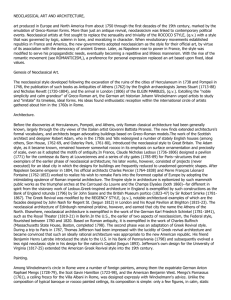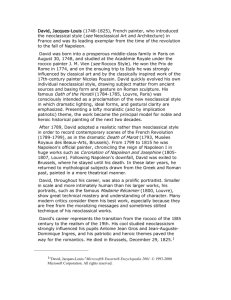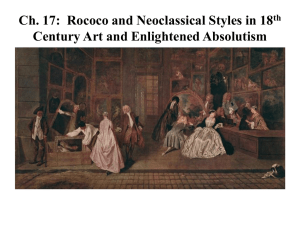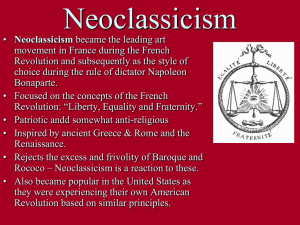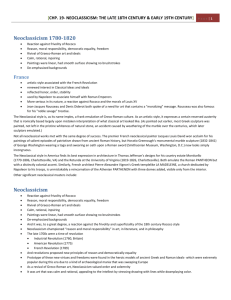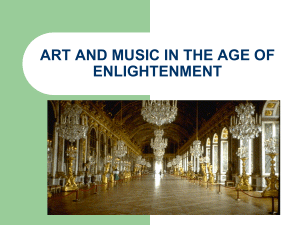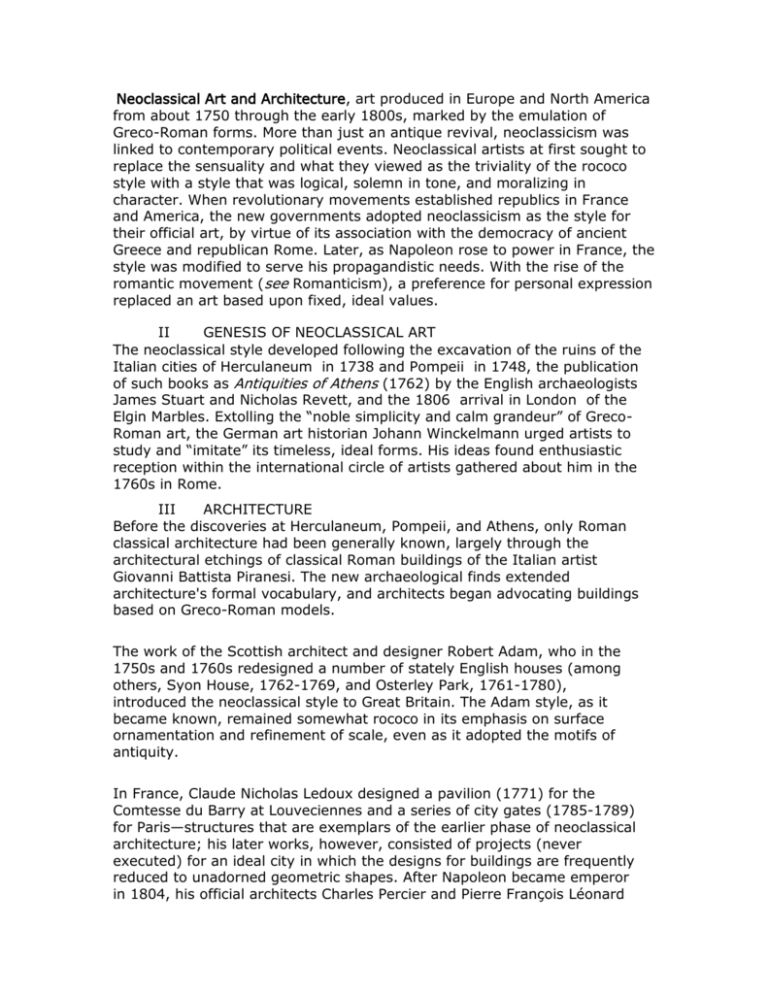
Neoclassical Art and Architecture, art produced in Europe and North America
from about 1750 through the early 1800s, marked by the emulation of
Greco-Roman forms. More than just an antique revival, neoclassicism was
linked to contemporary political events. Neoclassical artists at first sought to
replace the sensuality and what they viewed as the triviality of the rococo
style with a style that was logical, solemn in tone, and moralizing in
character. When revolutionary movements established republics in France
and America, the new governments adopted neoclassicism as the style for
their official art, by virtue of its association with the democracy of ancient
Greece and republican Rome. Later, as Napoleon rose to power in France, the
style was modified to serve his propagandistic needs. With the rise of the
romantic movement (see Romanticism), a preference for personal expression
replaced an art based upon fixed, ideal values.
II
GENESIS OF NEOCLASSICAL ART
The neoclassical style developed following the excavation of the ruins of the
Italian cities of Herculaneum in 1738 and Pompeii in 1748, the publication
of such books as Antiquities of Athens (1762) by the English archaeologists
James Stuart and Nicholas Revett, and the 1806 arrival in London of the
Elgin Marbles. Extolling the “noble simplicity and calm grandeur” of GrecoRoman art, the German art historian Johann Winckelmann urged artists to
study and “imitate” its timeless, ideal forms. His ideas found enthusiastic
reception within the international circle of artists gathered about him in the
1760s in Rome.
III
ARCHITECTURE
Before the discoveries at Herculaneum, Pompeii, and Athens, only Roman
classical architecture had been generally known, largely through the
architectural etchings of classical Roman buildings of the Italian artist
Giovanni Battista Piranesi. The new archaeological finds extended
architecture's formal vocabulary, and architects began advocating buildings
based on Greco-Roman models.
The work of the Scottish architect and designer Robert Adam, who in the
1750s and 1760s redesigned a number of stately English houses (among
others, Syon House, 1762-1769, and Osterley Park, 1761-1780),
introduced the neoclassical style to Great Britain. The Adam style, as it
became known, remained somewhat rococo in its emphasis on surface
ornamentation and refinement of scale, even as it adopted the motifs of
antiquity.
In France, Claude Nicholas Ledoux designed a pavilion (1771) for the
Comtesse du Barry at Louveciennes and a series of city gates (1785-1789)
for Paris—structures that are exemplars of the earlier phase of neoclassical
architecture; his later works, however, consisted of projects (never
executed) for an ideal city in which the designs for buildings are frequently
reduced to unadorned geometric shapes. After Napoleon became emperor
in 1804, his official architects Charles Percier and Pierre François Léonard
Fontaine worked to realize his wish to remake Paris into the foremost
capital of Europe by adopting the intimidating opulence of Roman imperial
architecture. The Empire style in architecture is epitomized by such
mammoth public works as the triumphal arches at the Carrousel du Louvre,
designed by Percier and Fontaine and begun in 1806, and the ChampsÉlysées, designed by Jean-François Chalgrin and begun the same year.
These works were far different in spirit from the visionary work of Ledoux.
Greek-inspired architecture in England is exemplified by such constructions
as the Bank of England rotunda (1796) by Sir John Soane and the British
Museum portico (1823-1847) by Sir Robert Smirke. The Greek Revival was
modified by the Regency style, notable architectural examples of which are
the facades designed by John Nash for Regent Street (begun 1812) in
London and his Royal Pavilion at Brighton (1815-1823). The neoclassical
architecture of Edinburgh, Scotland, remained pristine, however, and
earned that city the name the Athens of the North. Elsewhere, neoclassical
architecture is exemplified in the work of the German Karl Friedrich
Schinkel, such as the Royal Theater (1819-1821) in Berlin.
In the United States, one aspect of neoclassicism, the Federal style,
flourished between 1780 and 1820. Based on the work of Robert Adam, it is
exemplified in the work of Charles Bulfinch (Massachusetts State House,
Boston, completed 1798). Thomas Jefferson studied the Maison-Carrée, a
1st-century Roman temple in Nîmes, France, and used it as a model for the
State Capitol Building in Richmond, Virginia (1785-1789). Through his
readings and travels, Jefferson developed a profound understanding of
Roman architecture and applied his knowledge to the designs for his own
home, Monticello; the University of Virginia campus; and preliminary
contributions to the plans for the new national capital of Washington, D.C.
Jefferson's work exemplifies neoclassical style in the United States.
The Greek revival style, based on 5th-century BC Greek temples and
inspired by the Elgin Marbles, flourished during the first half of the 19th
century in the United States. The Second Bank of the United States
(Philadelphia, 1824), designed by William Strickland, was influenced by a
Doric temple. Both the Federal and Greek revival styles helped a young
United States define its own architectural ethos.
IV
PAINTING
Neoclassical painting was centered in Rome, where many expatriate
painters gathered around German art historian Johann Winckelmann.
Winckelmann's circle included the expatriate German Anton Raphael Mengs,
the Scot Gavin Hamilton, and the American Benjamin West. Mengs's
Parnassus (1761), a ceiling fresco for the Villa Albani in Rome, was
designed expressly with Winckelmann's advice. Unlike the composition of
typical baroque or rococo painted ceilings, its composition is simple: only a
few figures, in calm, static poses mainly derived from antique statues.
Hamilton, who was also an archaeologist and art dealer, completed five
pictures from 1760 to 1765 inspired by Homer's Iliad and incorporating
figures derived from ancient sculpture. West worked in Rome from 1760 to
1763. Paintings such as Agrippina Landing at Brundisium with the Ashes of
Germanicus (1768, Yale University Art Gallery, New Haven, Connecticut)
were inspired by his Roman experience. Solemn and austere in theme and
treatment, they are also archaeologically correct in detailing.
The same tendencies are evidenced in the earlier work of the French
painter Jacques-Louis David, who is recognized as the great genius of
neoclassical painting. His Oath of the Horatii (1784-1785, Louvre, Paris)
celebrates the theme of stoic patriotism. The picture's boxlike architectural
space and friezelike arrangement of figures reflect neoclassical concern for
compositional logic and clarity. The firm contours and harsh light lend these
figures a statuesque quality. Later works of David, commissioned by
Napoleon—such as Coronation of Napoleon and Josephine (1805-1807,
Louvre)—are very different, however, in their celebration of worldly
splendor and power. The emperor's approval of such ostentatious displays
was even extended to an American painter, John Vanderlyn, to whom he
awarded a medal in 1808 for his Marius Among the Ruins of Carthage
(1807, M. H. de Young Museum, San Francisco).
By the early 1790s painters began to emulate the flat, silhouetted figures of
Greek vase painting. The foremost exponent of this style was the English
painter John Flaxman, whose simple line engravings for editions (1793) of
Homer's Iliad and Odyssey completely replaced traditional perspective,
lighting, and modeling with flat linear design. The style was immensely
successful and widely imitated. One of David's most successful pupils, and
the inheritor of his role as leading interpreter of the classical tradition,
Jean-Auguste-Dominique Ingres adopted this two-dimensional approach,
as seen in his popular early work The Envoys of Agamemnon (1801, École
des Beaux-Arts, Paris).
V
SCULPTURE
Sculpture had been profoundly influenced by ancient art since the
Renaissance. Thus, neoclassical principles had a less revolutionary impact
on it than on the other arts. In general, neoclassical sculptors tended to
avoid the dramatic twisting poses and the colored marble surfaces
characteristic of late baroque or rococo sculpture, preferring crisp contours,
a noble stillness, and idealized white marble forms.
The earliest neoclassical sculpture was produced by artists in direct contact
with Winckelmann's circle in Rome—18th-century sculptors such as John
Tobias Sergel, who on his return to his native Sweden carried the new style
to northern Europe, and the Englishmen Thomas Banks and Joseph
Nollekens, who introduced the style to their homeland. The dominant figure
in the history of neoclassical sculpture, however, was the Italian Antonio
Canova, who became a member of the Rome circle in 1780. Rejecting his
earlier baroque manner, he sought to capture the severity and ideal purity
of ancient art. Theseus and the Dead Minotaur (1781-1782) portrays the
calm of victory rather than active conflict; the work was Canova's first
attempt at the new style, and it brought him immediate fame.
After Canova's death, the Danish artist Bertel Thorvaldsen inherited his
position as Europe's leading sculptor. His many international commissions
sustained strict neoclassicism as the dominant mode in sculpture until the
mid-19th century. The style was carried to the United States by one of his
friends, Horatio Greenough, and was continued by Hiram Powers, an
American long resident in Italy, sculptor of the celebrated Greek Slave
(1843), of which many replicas were made.
VI
DECORATIVE ARTS
The neoclassical style pervaded every type of decorative art. By the early
1760s Robert Adam's furniture designs revealed Greco-Roman motifs.
Introduced into France, his simple, classical style became known as style
étrusque (Etruscan style), favored by the court of Louis XV. With further
adaptations of classical design, based on later archaeological finds, it
evolved into the elegant style known as Louis XVI, favored by the royal
family during the 1780s. Greek vases found in excavations became models
for new types of ceramics: Wedgwood jasperware (for which Flaxman did
many designs) in England and Sèvres porcelain in France.
Under Napoleon, former royal residences were redecorated for official use
according to plans devised by Percier and Fontaine that included furniture,
porcelain, and tapestries, all incorporating Greco-Roman design and motifs.
Taken as a whole, such design complexes defined the Empire style in the
decorative arts, and the style was soon emulated throughout Europe.1
1"Neoclassical Art and Architecture."Microsoft® Encarta® Encyclopedia 2001. © 19932000 Microsoft Corporation. All rights reserved.

